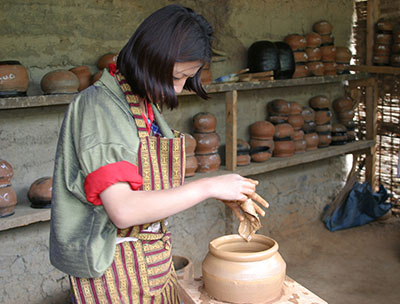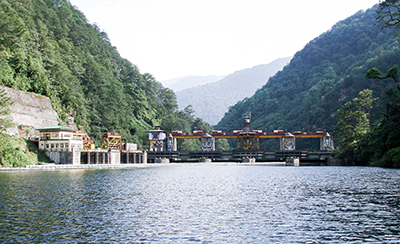 Despite Bhutan’ small population there has been much economic development in recent years and the economy is growing rapidly.
Despite Bhutan’ small population there has been much economic development in recent years and the economy is growing rapidly.
While a large part of the Bhutanese population is still illiterate and reside in rural areas with approximately 1in 5 still living under the poverty line, the majority of all Bhutanese have shelter and are self-sufficient. Rapid modernization has brought about vast improvements in the living standard of the Bhutanese people. All villages now have access to basic amenities such as education, running water, basic healthcare and are connected by roads and electricity. Even the most remote villages have connection to the telecommunication network including mobile phone service.
The Bhutanese economy is predominantly agricultural. Farmers supplement their income through the sale of animal products such as cheese, butter and milk. Farmers’ markets are common throughout the country, supplying the people with fresh, organic, local produce.
The main staple crops are rice, maize, wheat and buckwheat while cash crops are predominantly potatoes, apples, oranges, cardamom, ginger, and chilies. A fruit based industry has been established in the capital allowing farmers from the nearby areas to sell their produce and thereby earn additional revenue.

COTTAGE INDUSTRY
Bhutan’s rich biodiversity provides the country with ample forest resources and this has brought about the development of a thriving cane and bamboo handicraft industry. Craftsmen weave a number of beautiful and intricate items out of bamboo and cane including hats, backpacks, floor mats and traditional bowls. These items are then sold to tourists or Bhutanese, supplying a secondary income source.

TOURISM
The Bhutanese Tourism Industry was first opened in 1974. Since then it has grown to become, a major contributing factor to the Bhutanese economy creating countless employment opportunities and generating additional revenue for the government.
The government is committed to building a sustainable tourism industry that is not only financially viable but also limits the negative cultural and environmental impacts commonly associated with the culture of mass tourism. By establishing a policy of “High Value, Low Impact’ tourism, the kingdom of Bhutan seeks to ensure that it attracts only the most discerning visitors with a deep respect for cultural values, traditions and the natural environment.
To this end efforts have been made to ensure that even remote areas are publicized and able to reap the benefits of tourism while still respecting their traditions, culture and natural environment.

HYDROELECTRICITY
Due to its fast flowing, glacier-fed rivers, Bhutan has enormous potential to produce hydroelectricity. With the construction of several major dams, the power sector has undeniably been the biggest contributor to the Bhutanese exchequer. The Chukha Hydro Power Corporation, the Tala Hydro Power Corporation, the Baso Chu Hydro Power Corporation and the Kurichu Hydro Power Corporation, under the umbrella of Druk Green Power Corporation, are some of the existing mega projects in the country. The 1500 MW of power they generate, most of which is exported to our neighboring country India, barely scratches the surface of Bhutan’s untapped hydroelectric potential. With its abundant water resources, Bhutan still has the capacity to generate another 30,000 MW of electricity. However, the government is proceeding cautiously with new construction projects in order to minimize the impact upon the surrounding areas.
![]()
MANUFACTURING
The Manufacturing sector is another major contributor to national revenue. With the industrial sector established in Pasakha, small scale industries such as cement plants, calcium and carbide, steel and Ferro silicon, Coca Cola and also wood based industries have started developing.
As a result of the recent economic development, Bhutan has one of the highest per capita incomes in South Asia at US$1,321. However despite this high level of growth and development, efforts stringent regaliations have been enacted in order to protect Bhutan’s natural environment.
It is a government regulation that you must use a licensed Bhutanese tour operator to book your travel to Bhutan or one of their international partners.
There are a number of airports where you can fly into Bhutan from (Bangkok, Delhi, Kolkata, Bagdogra, Bodh Gaya, Dhaka, Kathmandu, Guwahati, Singapore and Mumbai.). At present two carriers operate to Bhutan, Drukair and Bhutan Airlines. Also, there are three land border crossings which you can travel into the kingdom overland. All crossings are along the Indian border only - Phuentsholing, Gelephu and Samdrup Jongkhar. All travel arrangements to Bhutan must be made through a local tour operator. A list of tour companies operating in Bhutan is available on this website. Your selected tour operator will make all the necessary arrangements.
The $200 per day (January, February, June, July, August) and $250 per day (March, April, May, September, October, November) package includes a minimum of 3 star accommodations, costs for food, an experienced guide and transportation within the country. Also included in the price is a $65 per day Sustainable Development Fee that goes towards free education, free healthcare and poverty alleviation. All of these services will be arranged by your tour operator.
Copyright © 2023 Teem Travel Bhutan All Rights Reserved